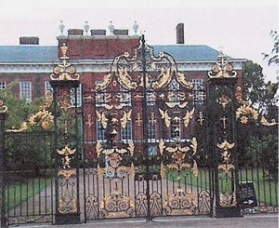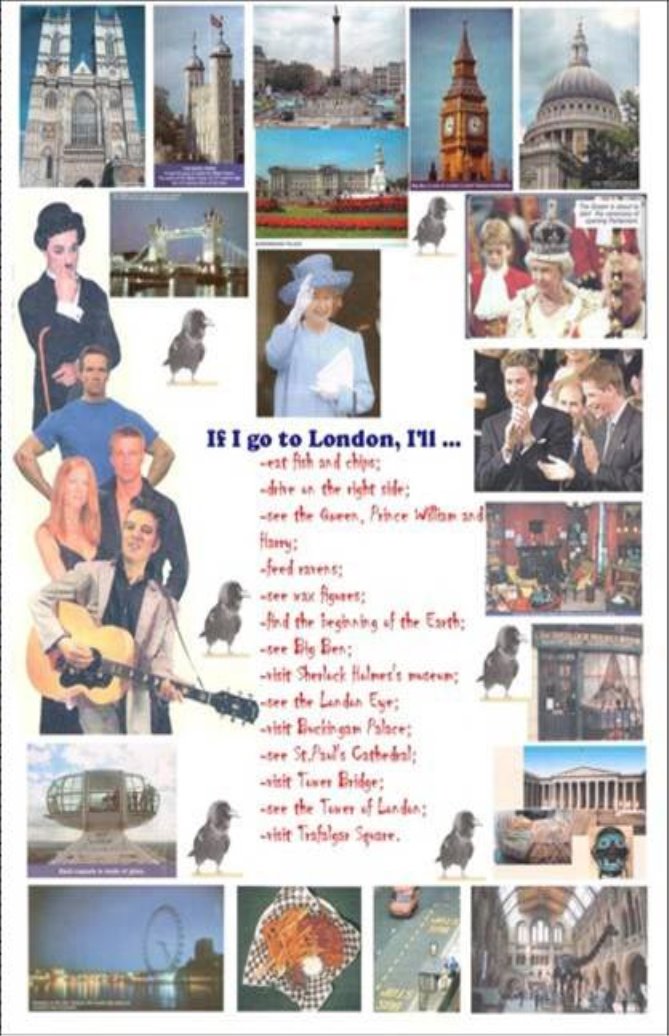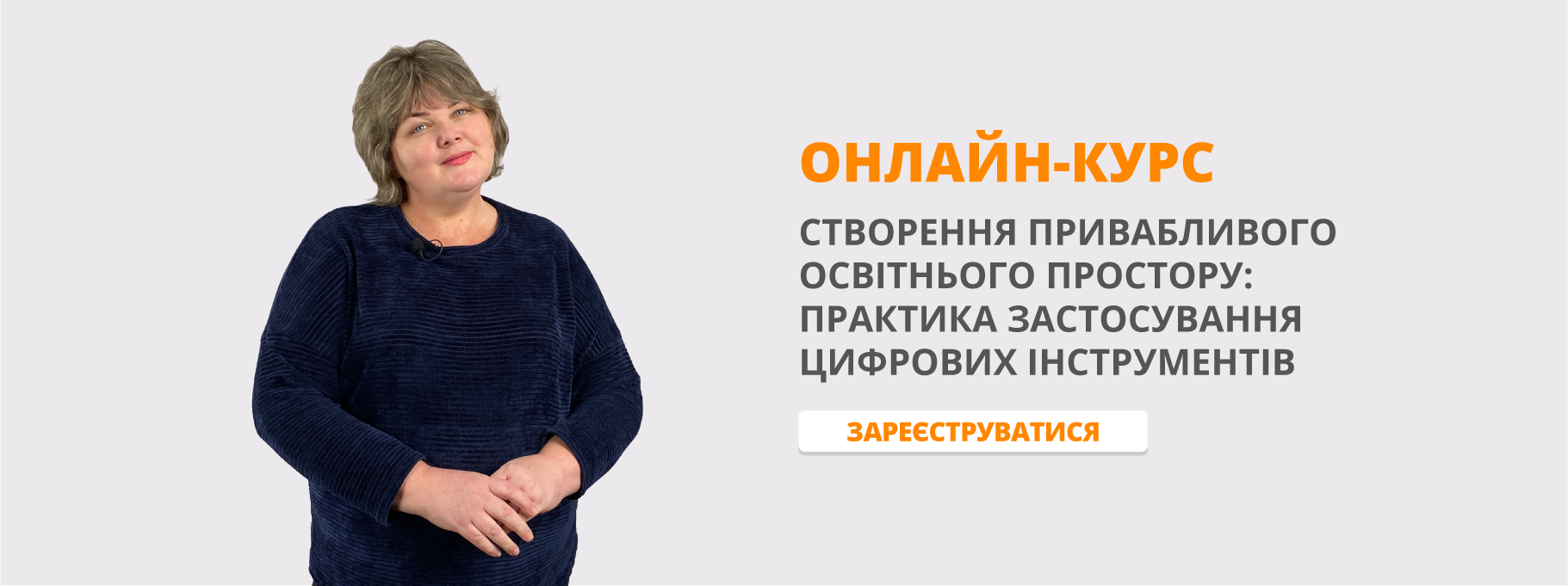Урок "A Trip to London"
Topic: English-speaking countries. Great Britain.
Subtopic: A trip to London.
Objectives: - to teach students to use prior knowledge on the topic;
- To review grammar material ( articles);
- to develop co-operative skills of pair and group work;
- to improve students` reading and listening skills;
- to practice speaking on the topic;
- to develop memory, stimulate logical thinking;
- to encourage students to respect the style of living of other nations, to be open-hearted.
Equipment: pictures, handouts, text for reading, charts.
The Procedure of the Lesson
I. Organization.
 T.: Good morning, children! Sit down, please! I am glad to see you! Do you remember what date it is today? What day of the week is it today? Look at the blackboard! We are having an unusual lesson. The topic of it is “A TRIP TO LONDON”. Today we are going to revise our material on the topic “TOWN LIFE. LONDON”: we’ll do some exercises, write a quiz, watch a film, work in groups, act out dialogues, play and sing the song “Do you live in London?”
T.: Good morning, children! Sit down, please! I am glad to see you! Do you remember what date it is today? What day of the week is it today? Look at the blackboard! We are having an unusual lesson. The topic of it is “A TRIP TO LONDON”. Today we are going to revise our material on the topic “TOWN LIFE. LONDON”: we’ll do some exercises, write a quiz, watch a film, work in groups, act out dialogues, play and sing the song “Do you live in London?”
“Looking down on London, we see at our feet the richest and the most beautiful city in the world as magic as Rome.
All of you dream of visiting London and let’s hope that some day our dream will come true and we’ll see one of the greatest cities in the world.
II. Phonetic and grammar drills.
T: Let’s take a plane and go on an imaginable trip to London. We arrive at Heathrow Airport and go to see London. But before going we must find some keys to this magic city which will show us the way there. Look at these gates. Your task is to fill in the definite article where necessary and find the keys. (add.1)
Add.1
…Tower of London
…St .Paul’s Cathedral
…Trafalgar Square
…National Gallery
…Buckingham Palace
…Westminster Abbey
…Houses of Parliament
…Big Ben
…Thames
…City
…Downing Street
…Parliament Square
…Oxford Street
…British Museum
…London Bridge
T.: Now repeat these proper nouns with me. Well done. We’ve found all the keys and now we can take a double-decker bus and go on our tour.
III. Pair Work
T.: Let’s remind what we know about London, what London is famous for. Look at the blackboard. Your task is to complete the sentences.
- London is the capital of … (England)
- More than … million people live in London. (7)
- The heart of London is … (The City)
- The political centre is … (Westminster)
- … lives in Buckingham Palace.(The Queen of England)
- One of the greatest and oldest churches is … (St. Paul’s Cathedral)
- … is in the centre of London. (Trafalgar Square)
- The most interesting museum is … (The Tower of London)
- The largest clock is … (Big Ben)
- London is situated on … (The Thames)
- … is one of the London’s most famous symbols. (Tower Bridge)
IV. Exercising.
T.: Well done. Now let’s get off our double-decker bus and have a rest a little. Let’s do exercises for our eyes (window-wall-ceiling-floor…).
Let’s do our exercises for our hands.
Up, down, up, down,
Which is the way to London Town?
Where? Where?
Up in the air,
Close your eyes
And you are there.
- Reading.
TRAFALGAR SQUARE
This is one of the sightseeings of London. It was named Trafalgar Square in memory of the historical victory won on the 21st of October 1805 by the British fleet under the command of Horatio Nelson over the combined French-Spanish fleet. The battle took place at Cape Trafalgar and lasted several hours; Nelson was fatally wounded by a shot which broke his backbone; He died on board his flagship the Victory, but not before being told that he had won the battle.
Nelson's Column, with the statue of Admiral Lord Nelson on top, rises in the centre of Trafalgar Square. This most impressive monument is 170 feet (about 52 m) tall. The statue of Nelson, placed facing towards the sea he loved, measures 17 feet (more than 5 m) in height.
To the north-east of Trafalgar Square there is the building that houses the National Gallery of Art - one of the most important Art Galleries in the world - and behind is the National Portrait Gallery.
Quite often the square becomes the location for meetings and in it crowds of Londoners congregate to celebrate political rallies. So it can be said that Trafalgar Square is the heart from which the beat is spread to all the Londoners.
There are many doves in the square and Londoners like to feed them. Everybody knows that the dove is the symbol of peace all over the world.
- Why was it named Trafalgar Square?
- Who was the British fleet under the command of?
- Did Admiral Nelson win the battle?
- What is there in the middle of the square?
- How tall is the statue?
- What buildings can we see to the north-east of Trafalgar Square?
- Why do Londoners gather in TS?
-
What birds is TS full of?
- Speaking.
What places would you like to visit in London?
What interesting facts about London do you know?
Your task is to prepare short monologues about the sightseeing.
|
|
|
|
- Discussing.
T: If you could visit London what would you do there? Please, make as many sentences as you can.
If I go to London, I`ll….
XI. Summary of the lesson.
T.: Did you enjoy our excursion? Thank you for your lesson. You worked well today. Your marks are…. Our lesson is over. Good-bye, my friends.



про публікацію авторської розробки
Додати розробку
